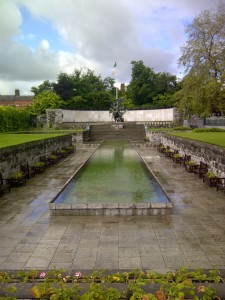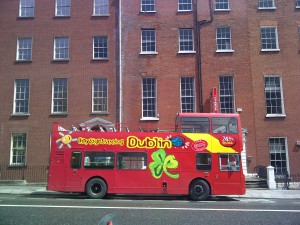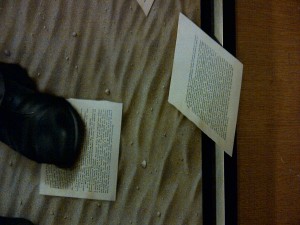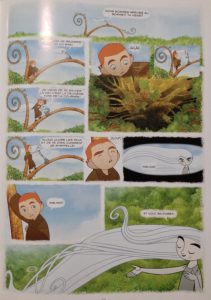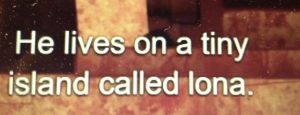Home » Celtic culture and mythology
Category Archives: Celtic culture and mythology
A1-A2-B1 Our film review of the Secret of Kells
https://fr.vikidia.org/wiki/Celtes
[youtube]http://www.youtube.com/watch?v=RZm1kVnZ7hk&feature=related[/youtube]
About the film: Where does the story take place?
1) It takes place in Iona in Scotland
2) It takes place in Kells in Ireland
3)Louis Le Bocquy, a painter (born in 1916) inspired the film-maker
3) The book was transferred in 806 from Iona in Scotland to Kells in Ireland
Who are the characters of the film?
Abbot Cellach:
1) he is a tall and protective man who lives in a tower
2)he forgot he was an illuminator in the past
3)he has got ginger hair
4)he lives in a tower to forget the past
Abbot Aidan:
1) He is of small size
2)he teaches Brendan how to draw or how to observe
Pangur Ban:
1) She is a real and mythical cat
2) She is only mythical
3) There are poems written by the monk in the archives which mention the cat
Aisling’s parents:
1) They were killed by Crom Cruach
2) They died when she was younger
3) They are still alive
Aisling:
1) She is a fairy and an angel
2) She is intelligent, careful and also very sensitive
3) She moves on four feet
4) She can transform herself into a wolf
Abbots Tang, Leonardo and Assoua:
1) They are all illuminators
2) They are allowed out of the monastery
3) They are not allowed out of the monastery
4)They are entirely dedicated to the scriptorium
5) They eventually/finally die but the spectator doesn’t see them
The Vikings:
1) They are not menacing shadows
2)They are represented as cruel animals
3) They represent death, unhappiness, dangers and tragedy, destruction and war, horror and blood
Crom Cruach:
1) He is a Celtic God with a snake
2)He represents the dragon as a legend
3) He was shot by Saint Patrick in Irish mythology
4)His name means “The Dark One”
What are the Celtic symbols in the film?
1) The square
2) The rectangle
3)The triangle
4)The circle
5) light modifies the scenes
6) light doesn’t modify the scenes
7) forest as paradise on earth
8) forest as opposed to flat landscapes
9) the circle as the symbol of harmony
10) the “triskele” is a Celtic symbol which is a representation of water, fire and earth
And now the story:
1) it starts when Brendan is a child and finishes when he is an adult
2)it is the story of the evolution of a young boy into adulthood
3)the Book is always present in Brendan’s mind
4)the Vikings are always present in Brendan’s Uncle’s mind
The Book of Kells:
1)The Book of Kells is a real book which is in Trinity College, Dublin, Ireland.
2)The Book of Kells isn’t a real book and doesn’t exist.
It is a legend.
What about Pangur Ban, the magic spell and spirit?
1)Pangur Ban, the white cat, existed. She is a female cat.
2)Pangur Ban the white cat never existed.
3)One of the monks wrote poems about her.
How is Celtic mythology represented ?
1) symbols inspired by nature and animist cults.
2) it is close to natural rites and rhythms
Can you name painters who inspired the artist?
The monastery is very beautiful.
The colors are original.
People are monks and priests.
Walls have got bizarre shapes.
Brendan is twelve years old.
He is an orphan: he hasn’t got any parents.
His father and his mother died.
He meets a very friendly girl: she is called Aisling!
She will help him. She is a fairy. He is looking for berries to make ink
because he wants to write the Chi Ro page.
Brendan is of medium height and size and has got ginger hair.
He lives in Kells in Ireland.
Brendan’s Uncle is the head of Kells.
He is taking care of other monks and people.
The book is very important to him.
The security and safeness of the monastery matters to him as well!
He lives in a tower which opens with a very narrow door.
He is very strict because he wants to save the monks and his people from the Northmen’s attacks.
The Secret Of Kells
Description of Aisling: long white hair and green eyes. She looks like a fairy and she is one! She has the power to turn the cat, Pangur Ban into a fish-cat, a spirit! She can use her spells!
Description of Brendan: short orange hair and blue eyes, long feet, curly and funny ears! He is the hero of the story and we can see him when he is older!
Description of the monks: Asian, African, all walks of life! They are wearing long red coats
I like the scene when :
– When the bad guys come and attack the town of Kells
– When Brendan goes into the forest to look for an eye
– When Brendan dreams that the Vikings will attack Kells because he has visions and can trust his imagination! He is a visionary!
– When Brendan makes a lot of drawings on the Book! He is inspiring!
I like the scenes when there is
- a lot of suspense and many battles
- when the forest is beautiful
- when the book is beautiful and turns into a magic spell!
- Pangur Ban is really cute with two different colours for his eyes! Pangur Ban did exist! He was one of the monk’s cat. The monk wrote poems about her!
Our film review about the Secret of Kells
I liked the scene when the little boy writes the sacred book
-I liked the discovery of the forest
-I liked the scene when he catches the monster’s eye.
-We liked the red and the green colours and the drawings!

My best scenes:
– The meeting between Aisling and Brendan
-She is quicker than Brendan,
she runs faster and she is the best!
-She has magical powers to trasnform nature .The cat can go where she cannot
My best favorite scenes
-When his Uncle is hurt, someone tells Brendan : « You must go, your Uncle is not dead! »
– Brendan disobeys his Uncle to pick up berries because he is not allowed to do so!
-Vikings’s attack and the wolves eat the Vikings in the forest
-Brendan thinks the bees will attack him but it is not true!
the Vikings ‘s attacks are in red
Aisling in the forest
the wolves ‘s scenes are also in red
Aisling ‘s eyes
the wolves ‘s eyes
beautiful nature: waterfalls, rivers, leaves in spring, leaves on trees, leaves falling down,
the Vikings’ s eyes
Pangur Ban
the monster Crumach
The scene when Brendan is writing
when the Vikings go Kells
When Brendan meets his uncle
The wolf’s lips and mouth
When Brendan writes the Book of Kells
the fire, the sky, the buildings, the walls, the attacks, the
Brendan catches the goose
Brendan’s UNCLE’s clothes
green berries for green ink
Aisling disappears and gets lost in darkness
red represents evil or a danger: it means something bad is going to happen
and green represents what is best and good in life, luck, happiness,
writing and drawing
BOOK of K E L L S Collège et cinéma Brendan and the Secret of Kells
Long ago, when the Vikings crossed the seas to raid Ireland, a boy called Brendan lived in a village not far from
the great monastery of Kells.
One terrible day, the Vikings attacked Brendan’s village
and left no one alive- except little Brendan!
click http://LearningApps.org/view3131279 and watch!
http://LearningApps.org/view1361649 about King Arthur, a very famous Celtic King
a forest spirit named Aisling.
the Eye of Collum-Cille
Crom Cruach, a Celtic pagan deity
Opening scene:
-“Catch him, Brendan! Don’t let him go!” The goose is running very fast.
-“We’ve got him!”
The walls of the Abbot’s room are full of drawings!
-“We are artists, not builders!” said Brother leonardo crossly.
A stranger arrives with a white cat!
From Brother Aidan’ s study room to the forest:
Brendan took down the stachel (bag) and opened it!
-“Oh! Brother Aidan! I… mean no harm. I just wanted to look at the Book.”
The “Chi Ro” page is the most glorious page in the entire book.
The monks use ink, the deepest emerald green ink! They grow an old oak trees in the forest.”
Brendan’s face: ‘I am not allowed in the forest. It is too dangerous.’
-“Oh, Pangur, I really want to help Brother Aidan. Maybe I could go into the forest.
The two friends crept through the passage between the stones. They hurried into the dark forest.
Finally, they reached a clearing (woods with trees) and stopped to catch their breath.
Wolves! Brendan picked up a stick and swung it around like a sword. The wolves started making noises.
Brendan closed his eyes and begun to pray.
http://LearningApps.org/view3188048
-“Is this your cat?”
A small white-haired girl, about eight years old, stood in front of the stone, holding Pangu Ban.
-“You’re a… a fairy! What are you doing here?”
-“What are you doing here- in my forest? You’ve come to spoil it, haven’t you? Where are the rest of your family?
Cutting down trees or hunting the animals, I suppose?”
-‘I haven’t come to spoil anything! And I don’t have a family.’
-‘No mother?’
-“No?” Brendan said, “no mother, and no father either.”
-‘I’m alone too. My name is Aisling, what’s yours?”
-‘Brendan. And I’m jsut here to find berries to make ink. Do you know where these grow?”
-‘I could help you find them’ Aisling said, ‘but only if you and your cat promise never to come into my forest again!’
-‘We promise.’
-‘Come on, then.’
Aisling led Brendan and Pangur throught the forest, stopping to ask birds and animals for directions to the oak tree.
Finally she stopped under a huge tree and pointed straight up. It was a very long way to the top.
Aisling looked very strong. She managed to climb trees, all of them! Tall trees, thick trees, large trees, all of them!
But Brendan had difficulties climbing, he was trying to breathe.
Aisling was already at the bottom.
-‘Are you alright?’ Aisling asked anxiously.
-‘I’m fine. I just jumped the last bit.’
Pangur looked at him and shook her head.
Brendan left the path and found a cave.
-‘Careful! Be carefu! Evil ahead of you!’
-‘What do you mean?’
‘Crom Cruach? It is not a story … The Dark One is real. Run!’
‘It isn’t your world, Brendan? You must trust me! We need to go home!’
Back at the Abbey:
‘Brendan! Where have you been?’
‘I … I went into the forest. For brother Aidan, to get berries to make ink… for the BooK.’
‘I said it to you. You must not and shouldn’t leave the Abbey.’
‘Yes, Uncle. I’m sorry, I apologize.’
‘Now, come along. I have work for you in the tower.’
Later that night…
-‘Aidan! Wake up!
The next day refugees arrived at the abbey gates. The Vikings were getting closer! The monks worked even harder on the walls.
And Brendan worked on his drawing. Aidan was very pleased with his progress.
-‘Brendan, I have a confession. I cannot do the Chi Ro page. My old hands are too shaky and my eyes too dim. YOU must do it.’
-‘Me? No. I would ruin it. There must be someone else-‘
-‘You just have to trust in yourself and your imagination.’
For once (for the first time in his life), Brendan was glad to hear Abbot Cellach calling him.
Aidan drew a shape on a piece of paper and placed Brendan’s hand on it. The Eye of Crom Cruach was there!
-‘I cannot give up the Book, Uncle!’
Saved by Aisling:
-‘The only key to the Tower is in the Abbot’s room. ‘
-‘Now, Little Cat.’ said Aisling softly ‘You must go where I cannot.’
Aisling begun to croon softly into Pangur’s ear. Pangur’s shape slowly dissolved into thin white cloud.
The mist-cat turned and twisted inside the room, then reached out and lifted the key from the hook by the door.
-Where are you going?’
-‘The Eye of Crom!’
-‘No, Aisling. It’s a crystal and I think there’s one in the Dark One’s cave.’
Aisling is very sad and also frightened. She doesn’t want her friend to go to Crom Cruach’s place.
-‘Crom Cruach took my people. It took my mother. You will die!’
-‘The Book is Knowledge and Hope and Inspiration. it will be a treasure far beyond our time, a treasure forever.’
-‘This place is hurting you, Aisling. You must go back.’
The fight with the monster:
Again and again, the monster tried to consume Brendan; each time Brendan ducked out of its way( trying to escape).
The serpent raced towards Brendan. Brendan drew a big circle. The monster screamed in frustration.
Brendan reached for the monster’s eye. The eye came free. Pangur Ban was happy to see her her friend alive and well.
In the scriptorium and the arrival of the Vikings:
Brendan lay asleep on his desk, his hand covering a small piece of vellum. Aidan gently moved his hand and looked at Brendan’ s
creation throught the crystal. Very small creatures seemed alive under the glass, perfect in every detail. He called the other Brothers and they looked
at Brendan’s creation through the crystal. They were amazed at Brendan’s work.
They told Brendan to go in the tower because it was too dangerous to stay with the Northmen. They slammed the door and locked it behind
him.
The monks said to Brendan :
-‘ The Northmen killed everyone on Iona; they will leave no one in Kells. Your uncle lived to protect you. Now I must protect you, for Cellach and for the Book.’
The Northmen had destroyed part of the book, the vellum pages started floating gently to the ground.
Brendan started collecting them. The wolf had big blue eyes and was watching them. He suddenly disappeared.
Time passes by. Brendan is now a young adult and he is paying a visit to his Uncle who is old.
from wikipedia:
Brendan Gleeson as Abbot Cellach: A former illuminator himself, Abbot Cellach now uses his talents for the purposes of designing a wall to protect the Abbey of Kells from invasion. He is very concerned for everyone’s safety, especially that of his nephew Brendan, to the point where he thinks of little else but the completion of his wall. Eventually, this leads to his downfall.
Liam Hourican as Brother Tang and Brother Leonardo: Two illuminators, the former from Asia and the latter from Italy.
Mick Lally as Brother Aidan: As the Vikings attacked the Scottish island of Iona, master illuminator Brother Aidan fled with his cat, Pangur Bán. In Kells, he acquires Brendan as an assistant.
Evan McGuire as Brendan: The main character of the film, twelve-year-old Brendan is bright, imaginative and curious, but leads a sheltered life due to his uncle forbidding him from venturing outside the walls of Kells. Brendan is very interested in the art of illumination, and spends much of his time in the scriptorium with some of the Brothers in the abbey. He is recruited as Aidan’s assistant to help finish his great book. His uncle Abbot Cellach, an approaching Viking horde, a snake god and his own fears stand in the way of bringing the finished book to the people.
Michael McGrath as Adult Brendan
Christen Mooney as Aisling: Aisling is a fairy, related to the Tuatha De Danann, living in the woods outside of Kells. She is a protector of the forest, and doesn’t like unwelcomed guests. At this point her age is uncertain, but she is likely to be hundreds of years old. Despite being terrified of Crom Cruach, the evil god that dwells in a cave deep within her forest, she becomes loyal to Brendan and does whatever she can to help him. She has many magical abilities, and often takes the form of a white wolf.
Paul Tylack as Brother Assoua: An illuminator from Africa.
Paul Young as Brother Square: An illuminator from England.
The name Book of Kells is derived from the Abbey of Kells in Kells, County Meath, which was its home for much of the medieval period. The date and place of production of the manuscript have been the subject of considerable debate. Traditionally, the book was thought to have been created in the time of Columba,[4]paleographic and stylistic grounds: most evidence points to a composition date ca. 800,[5] long after St. Columba’s death in 597. The proposed dating in the 9th century coincides with Viking raids on Iona, which began in 794 and eventually dispersed the monks and their holy relics into Ireland and Scotland.[6] There is another tradition, with some traction among Irish scholars, that suggests the manuscript was created for the 200th anniversary of the saint’s death.[7] possibly even as the work of his own hands.
Rescued by his uncle, Cellach,
Brendan has lived ever since among the monks in the monsatery,
under strict instructions not to go beyond the walls!
Have a look at the maps!
http://www.undiscoveredscotland.co.uk/usaccomm/index.html
photos of Iona, July 2007 by Marie André-milesi
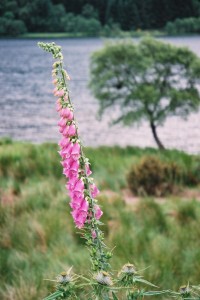
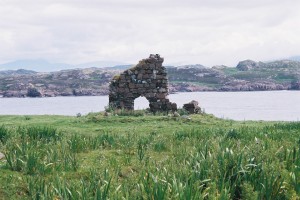
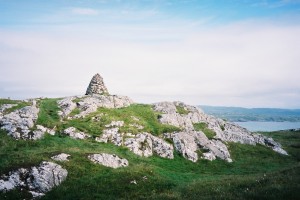

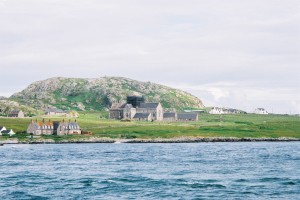
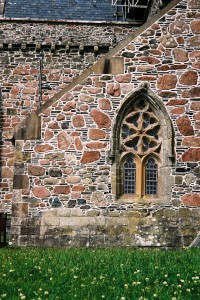 [youtube]http://www.youtube.com/watch?
[youtube]http://www.youtube.com/watch?

Key words:
A stranger arrives with a white cat!

Chapter 38 Jane Eyre
Chapter 38 Jane Eyre
Conclusion
Reader, I married him. A quiet wedding we had: he and I, the parson and clerk, were alone present. When we got back from church, I went into the kitchen of the manor-house, where Mary was cooking the dinner and John cleaning the knives, and I said –
casual and detached tone: not usually attributed to someone who makes such an announcement
“Mary, I have been married to Mr. Rochester this morning.” The housekeeper and her husband were both of that decent phlegmatic order of people, to whom one may at any time safely communicate a remarkable piece of news without incurring the danger of having one’s ears pierced by some shrill ejaculation, and subsequently stunned by a torrent of wordy wonderment. Mary did look up, and she did stare at me: the ladle with which she was basting a pair of chickens roasting at the fire, did for some three minutes hang suspended in air; and for the same space of time John’s knives also had rest from the polishing process: but Mary, bending again over the roast, said only –
“Have you, Miss? Well, for sure!”
A short time after she pursued–“I seed you go out with the master, but I didn’t know you were gone to church to be wed;” and she basted away. John, when I turned to him, was grinning from ear to ear.
“I telled Mary how it would be,” he said: “I knew what Mr. Edward” (John was an old servant, and had known his master when he was the cadet of the house, therefore, he often gave him his Christian name)–“I knew what Mr. Edward would do; and I was certain he would not wait long neither: and he’s done right, for aught I know. I wish you joy, Miss!” and he politely pulled his forelock.
“Thank you, John. Mr. Rochester told me to give you and Mary this.” I put into his hand a five-pound note. Without waiting to hear more, I left the kitchen. In passing the door of that sanctum some time after, I caught the words –
“She’ll happen do better for him nor ony o’t’ grand ladies.” And again, “If she ben’t one o’ th’ handsomest, she’s noan faal and varry good-natured; and i’ his een she’s fair beautiful, onybody may see that.”
I wrote to Moor House and to Cambridge immediately, to say what I had done: fully explaining also why I had thus acted. Diana and Mary approved the step unreservedly. Diana announced that she would just give me time to get over the honeymoon, and then she would come and see me.
“She had better not wait till then, Jane,” said Mr. Rochester, when I read her letter to him; “if she does, she will be too late, for our honeymoon will shine our life long: its beams will only fade over your grave or mine.”
How St. John received the news, I don’t know: he never answered the letter in which I communicated it: yet six months after he wrote to me, without, however, mentioning Mr. Rochester’s name or alluding to my marriage. His letter was then calm, and, though very serious, kind. He has maintained a regular, though not frequent, correspondence ever since: he hopes I am happy, and trusts I am not of those who live without God in the world, and only mind earthly things.
teasing the reader
You have not quite forgotten little Adele, have you, reader? I had not; I soon asked and obtained leave of Mr. Rochester, to go and see her at the school where he had placed her. Her frantic joy at beholding me again moved me much. She looked pale and thin: she said she was not happy. I found the rules of the establishment were too strict, its course of study too severe for a child of her age: I took her home with me. I meant to become her governess once more, but I soon found this impracticable; my time and cares were now required by another–my husband needed them all. So I sought out a school conducted on a more indulgent system, and near enough to permit of my visiting her often, and bringing her home sometimes. I took care she should never want for anything that could contribute to her comfort: she soon settled in her new abode, became very happy there, and made fair progress in her studies. As she grew up, a sound English education corrected in a great measure her French defects; and when she left school, I found in her a pleasing and obliging companion: docile, good-tempered, and well-principled. By her grateful attention to me and mine, she has long since well repaid any little kindness I ever had it in my power to offer her.
first ending: all’s-well-that-ends-well music or how the heath has its well-hidden enchantment and rewarding side in store
My tale draws to its close: one word respecting my experience of married life, and one brief glance at the fortunes of those whose names have most frequently recurred in this narrative, and I have done.
I have now been married ten years. I know what it is to live entirely for and with what I love best on earth. I hold myself supremely blest–blest beyond what language can express; because I am my husband’s life as fully is he is mine. No woman was ever nearer to her mate than I am: ever more absolutely bone of his bone and flesh of his flesh. I know no weariness of my Edward’s society: he knows none of mine, any more than we each do of the pulsation of the heart that beats in our separate bosoms; consequently, we are ever together. To be together is for us to be at once as free as in solitude, as gay as in company. We talk, I believe, all day long: to talk to each other is but a more animated and an audible thinking. All my confidence is bestowed on him, all his confidence is devoted to me; we are precisely suited in character–perfect concord is the result.
Mr. Rochester continued blind the first two years of our union; perhaps it was that circumstance that drew us so very near–that knit us so very close: for I was then his vision, as I am still his right hand. Literally, I was (what he often called me) the apple of his eye. He saw nature–he saw books through me; and never did I weary of gazing for his behalf, and of putting into words the effect of field, tree, town, river, cloud, sunbeam–of the landscape before us; of the weather round us–and impressing by sound on his ear what light could no longer stamp on his eye. Never did I weary of reading to him; never did I weary of conducting him where he wished to go: of doing for him what he wished to be done. And there was a pleasure in my services, most full, most exquisite, even though sad- -because he claimed these services without painful shame or damping humiliation. He loved me so truly, that he knew no reluctance in profiting by my attendance: he felt I loved him so fondly, that to yield that attendance was to indulge my sweetest wishes.
One morning at the end of the two years, as I was writing a letter to his dictation, he came and bent over me, and said–“Jane, have you a glittering ornament round your neck?”
I had a gold watch-chain: I answered “Yes.”
“And have you a pale blue dress on?”
I had. He informed me then, that for some time he had fancied the obscurity clouding one eye was becoming less dense; and that now he was sure of it.
He and I went up to London. He had the advice of an eminent oculist; and he eventually recovered the sight of that one eye. He cannot now see very distinctly: he cannot read or write much; but he can find his way without being led by the hand: the sky is no longer a blank to him–the earth no longer a void. When his first- born was put into his arms, he could see that the boy had inherited his own eyes, as they once were–large, brilliant, and black. On that occasion, he again, with a full heart, acknowledged that God had tempered judgment with mercy.
My Edward and I, then, are happy: and the more so, because those we most love are happy likewise. Diana and Mary Rivers are both married: alternately, once every year, they come to see us, and we go to see them. Diana’s husband is a captain in the navy, a gallant officer and a good man. Mary’s is a clergyman, a college friend of her brother’s, and, from his attainments and principles, worthy of the connection. Both Captain Fitzjames and Mr. Wharton love their wives, and are loved by them.
second ending: “See, reader, you are mistaken… do you think I am so foolish to make it so simple for you!”
As to St. John Rivers, he left England: he went to India. He entered on the path he had marked for himself; he pursues it still. A more resolute, indefatigable pioneer never wrought amidst rocks and dangers. Firm, faithful, and devoted, full of energy, and zeal, and truth, he labours for his race; he clears their painful way to improvement; he hews down like a giant the prejudices of creed and caste that encumber it. He may be stern; he may be exacting; he may be ambitious yet; but his is the sternness of the warrior Greatheart, who guards his pilgrim convoy from the onslaught of Apollyon. His is the exaction of the apostle, who speaks but for Christ, when he says–“Whosoever will come after me, let him deny himself, and take up his cross and follow me.” His is the ambition of the high master-spirit, which aims to fill a place in the first rank of those who are redeemed from the earth–who stand without fault before the throne of God, who share the last mighty victories of the Lamb, who are called, and chosen, and faithful.
St. John is unmarried: he never will marry now. Himself has hitherto sufficed to the toil, and the toil draws near its close: his glorious sun hastens to its setting. The last letter I received from him drew from my eves human tears, and yet filled my heart with divine joy: he anticipated his sure reward, his incorruptible crown. I know that a stranger’s hand will write to me next, to say that the good and faithful servant has been called at length into the joy of his Lord. And why weep for this? No fear of death will darken St. John’s last hour: his mind will be unclouded, his heart will be undaunted, his hope will be sure, his faith steadfast. His own words are a pledge of this –
“My Master,” he says, “has forewarned me. Daily He announces more distinctly,–‘Surely I come quickly!’ and hourly I more eagerly respond,–‘Amen; even so come, Lord Jesus!'” Book of Revelation (I Am Coming Quickly) may be attributed to the apostle John
Vote

Margaret Crawford has made sure she is registered to vote on 3 May
|
A 100-year-old woman who was eligible to vote in the 1929 General Election has urged people in Scotland to register for the 3 May poll.
Margaret Crawford’s message from her Cameron Park Nursing Home in Edinburgh was clear: “Don’t waste your vote.”
The centenarian took part in the first UK election in which women aged 21 to 30 were able to vote.
UK, Commonwealth or EU citizens, aged 18 and over, are entitled to vote in May if they register by 18 April.
In 1918, the suffragette movement achieved voting rights for women over the age of 30 and in 1928 women aged 21 to 30 were given the opportunity to vote.
Take for granted
Ms Crawford’s call for people to register for the Scottish Parliament and local authority elections is part of the politically neutral Vote Scotland campaign spearheaded by the Electoral Commission and Scottish Executive.

The Vote Scotland campaign was launched in March
|
Andy O’Neill, head of the Electoral Commission’s Scotland Office, said: “It’s easy to take the right to vote for granted.
“It is important to remember that at one time everyone did not have this right.
“This makes it all the more important that people make sure that they are on the register.”
People who are unsure whether they are registered – or want to change their details – are advised to contact their local electoral registration office.
They can also apply to vote by post or proxy. Information is available from the Vote Scotland website at www.votescotland.com.




